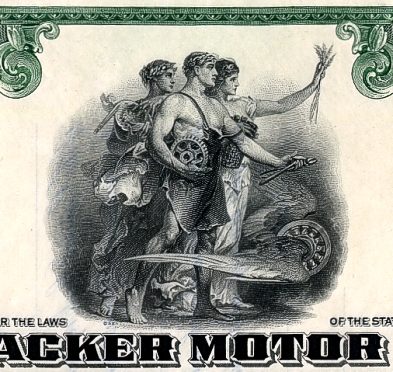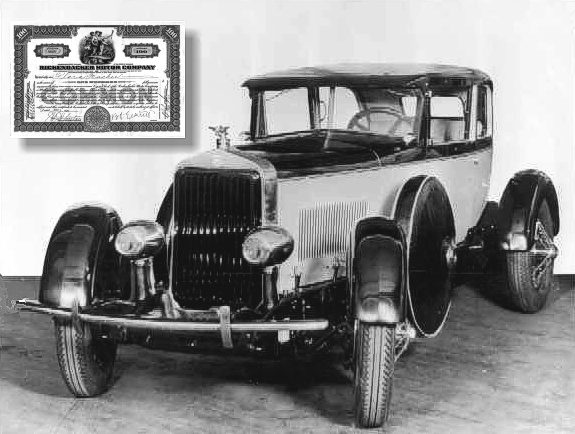Beautifully engraved certificate from the Rickenbacker Motor Company issued in 1926. This historic document was printed by the American Banknote Company and has an ornate border around it with a vignette of allegorical figures with gears and wings on a wheel. This item is hand signed by the company's president, Barney Everitt and is over 99 years old.

Certificate Vignette

Old PhotoShown for Illustrative Purposes
Eddie Rickenbacker was born October 8, 1890, in Columbus, Ohio. With little formal schooling and a succession of jobs behind that, he began working for a railroad car manufacturing firm in 1905. There he developed a deep interest in internal-combustion engines and engine-powered vehicles. He began driving racing cars at sixteen (he became a regular at the Indianapolis 500 from its first year, 1911). By the time the United States entered World War I he was internationally famous as a daredevil speed driver and held a world speed record of 134 miles per hour. In 1917 he enlisted in the army and went to France as a member of Gen. John J. Pershing's motor car staff. With help from Col. William Mitchell, he secured a transfer to the Air Service in August, took pilot's training, and early in 1918, with rank of captain, was assigned to the 94th Aero Pursuit Squadron. The 94th, which adopted the famous hat-in-the-ring insignia, was the first U.S. flying unit to participate actively at the front, fighting the "flying circus" commanded by the German ace, Baron Manfred von Ricthofen. In May 1918 Rickenbacker succeeded to command the 94th in the temporary rank of major. By the end of the war the 94th had downed 69 enemy craft, of which Rickenbacker, the "ace of aces" accounted for 26 (22 airplanes, 4 observation balloons). He earned every decoration possible, including the Medal of Honor, awarded in 1931 for his lone attack on seven German planes, two of which he downed, on September 25, 1918. His Fighting the Flying Circus appeared in 1919. In 1921, the Rickenbacker Motor Company was formed using the hat-in-the-ring insignia as its emblem. The company manufactured stylish, mid-priced cars, but was not successful and closed in 1927. Its demise was due, in part, to the introduction of four-wheel brakes which were rejected by the industry for marketing reasons. The next year he bought a controlling interest in the Indianapolis Speedway, which he returned until 1945. He later worked for the Cadillac division of General Motors Corporation and then was associated with a number of aircraft manufacturers and airlines. In 1935 he became general manager and vice president of Eastern Airlines. Three years later he became president and director of the line. His experience and technical knowledge prompted his appointment as special representative of Henry L. Stimson, Secretary of War, to inspect air bases in the Pacific theater of war in 1942. In October 1942, on his second mission over the Pacific, his B-17, crashed some 600 miles north of Samoa, and he and seven men (one of whom died) were adrift on rubber rafts with only fish and rain water to sustain them*. After 23 days he was rescued, and after a two-week rest, he resumed his tour**. After the war he returned to Eastern Airlines, where he remained, from 1954 as chairman of the board, until his retirement in 1963. He died in Zurich, Switzerland, on July 23, 1973.
The Rickenbacker Motor Company was incorporated in July of 1921 when Barney Everitt decided to start up another car company. He asked Eddie Rickenbacker for the use of his name on the automobiles and named Eddie vice-president & director of sales for the company. Everitt also asked long time friend and businessman Walter Flanders to help get this car company off the ground. Everitt & Flanders worked together before with William Metzger at the EMF car company from 1909-1912. A plant on Michigan Avenue in Detroit was purchased where 200 cars a day could be manufactured. (Later a newer plant was built at 4815 Cabot Avenue) The general public had yet to see the Rickenbacker prototype, but anything associated with Captain Eddie Rickenbacker was bound to be something extraordinary. The emblem for the car was taken from Rickenbacker's flying squadron insignia the "Hat in the Ring." In January of 1922 the first Rickenbacker touring cars, sedans, and coupes made their debut at the New York Auto show. The engine was a three-main- bearing six cylinder, 218 cubic inches, 58 hp with a speed of 60 mph. The cars were vibration less with two flywheels at either end of the crankshaft. This was an idea Rickenbacker had come up with while flying over Germany. He had been amazed at the German planes maneuverability and on inspection of several engines, found a flywheel at the end of the crankshaft. Also new on the Rickenbacker was an experimental chassis with four-wheel brakes. Few people paid much attention to this feature. By March of 1922, the factory was making 10 Rickenbackers a day. By May, the numbers had increased to 50. Rickenbacker announced on June 27th , 1923 that all Rickenbackers built from now on would have four-wheel brakes. Packard had made the same statement 16 days earlier, but only offered it on their eight-cylinder models. The Rickenbacker was the first medium priced American car with four-wheel brakes. Duesenberg had been the first to offer the option, but Duesenbergs were far from meduim-priced. Buick, Oakland, Cadillac, Marmon, Chalmers, Elgin, Paige and Locomobile were next to jump on four-wheel brake bandwagon. Few people seemed to remember that Rickenbacker had been making cars with four-wheel brakes since 1922, although few models came with the option in 1922. Car makers who did not offer a four-wheel brake model claimed that four-wheel brakes were dangerous. This campaign hurt Rickenbacker sales slightly, even though there was nothing unsafe about the design. Two companies leading these negative ads were the Ford Motor Company & Studebaker. The main reason for these ads really had nothing to do with the safety of the brakes. Ford & Studebaker had thousands of chassis in stock with two wheel brakes and nothing on the engineering table to start building a car with four wheel brakes. The negative campaign was to slow down the selling of four wheel braking auto's until their stock piles to two wheel chassis were used up. In 1923, the death of Walter Flanders (automobile accident) who had been instrumental in the design of the Rickenbacker, had a negative impact on the company. By the end of 1923, production numbers were just under 6,000 models which was less than expected. In 1924, Rickenbacker introduced the Vertical 8 Super-fine. This was indeed a fine automobile with a carbureted nine bearing L-head 268 cubic inch engine, dual ignition, dual muffler and the dual flywheel system. The price started at $2,195. Unfortunately, the Vertical 8 Super-fine was also costly to produce. By the end of 1924 the net profit for the company was dropping. Everett was still determined to keep the company going and beefed up the horsepower on the six and eight cylinder models slightly. However, in July 1925, Everett made a costly mistake. He dropped the price tag on the Vertical 8. This startled many dealers and stock holders in the company. At the 1926 New York Auto Show the Rickenbacker Motor Company deputed it's new Super Sport Boattail Coupe for $5000. They claimed it was the fastest production car to carry 4 people at just under 100 mph. Duesenberg, Stutz, Packard, and the likes had cars that could go faster, BUT they could only haul 2 people!! It's believed less than 20 of these cars were ever produced. In September of 1926, Eddie Rickenbacker resigned from the company due to constant bickering and other problems. This would prove to be the downfall of the car that bore his name. Hearing of Captain Eddie's departure, other influential people in the company began to leave as well. Everett was now pretty much on his own. Everitt made a last valiant attempt to keep the company going and announced that there would be 500 new cars available for 1927. In February, he was forced to give up. A total of 517 cars were made in 1927. History from Rickenbacker Motors.








